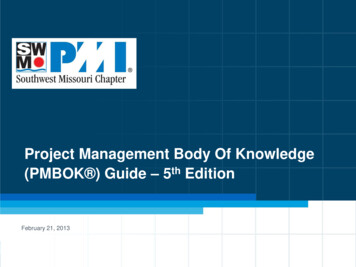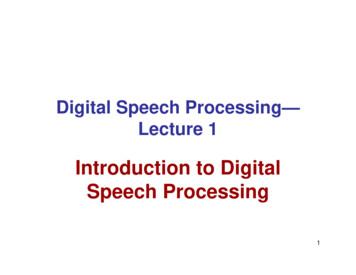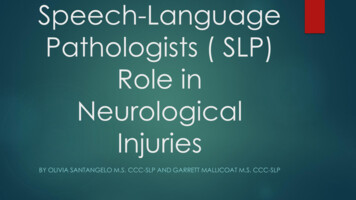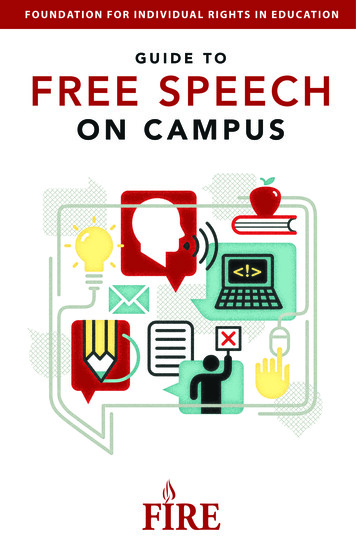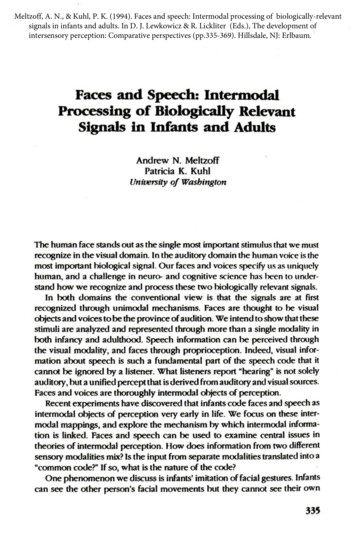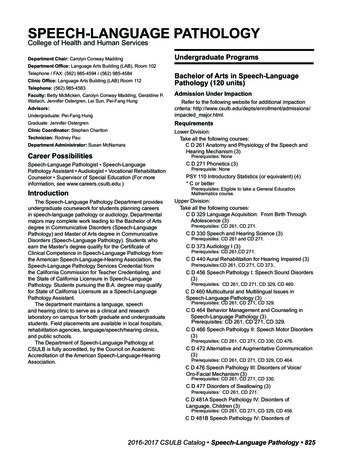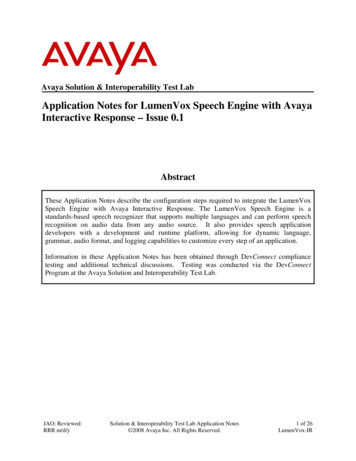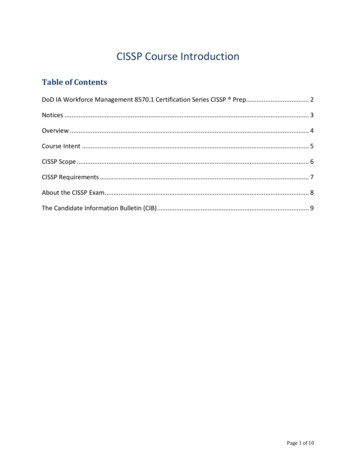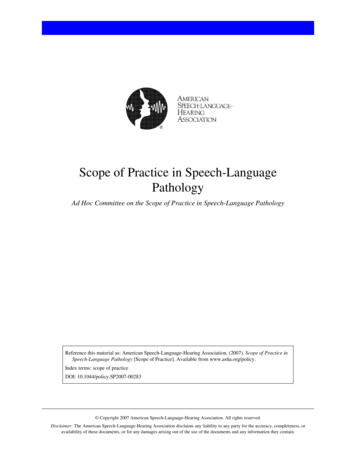
Transcription
Scope of Practice in Speech-LanguagePathologyAd Hoc Committee on the Scope of Practice in Speech-Language PathologyReference this material as: American Speech-Language-Hearing Association. (2007). Scope of Practice inSpeech-Language Pathology [Scope of Practice]. Available from www.asha.org/policy.Index terms: scope of practiceDOI: 10.1044/policy.SP2007-00283 Copyright 2007 American Speech-Language-Hearing Association. All rights reserved.Disclaimer: The American Speech-Language-Hearing Association disclaims any liability to any party for the accuracy, completeness, oravailability of these documents, or for any damages arising out of the use of the documents and any information they contain.
Scope of Practice in Speech-Language PathologyAbout ThisDocumentScope of PracticeThis scope of practice document is an official policy of the American SpeechLanguage-Hearing Association (ASHA) defining the breadth of practice withinthe profession of speech-language pathology. This document was developed bythe ASHA Ad Hoc Committee on the Scope of Practice in Speech-LanguagePathology. Committee members were Kenn Apel (chair), Theresa E. Bartolotta,Adam A. Brickell, Lynne E. Hewitt, Ann W. Kummer, Luis F. Riquelme, JenniferB. Watson, Carole Zangari, Brian B. Shulman (vice president for professionalpractices in speech-language pathology), Lemmietta McNeilly (ex officio), andDiane R. Paul (consultant). This document was approved by the ASHA LegislativeCouncil on September 4, 2007 (LC 09-07).****IntroductionThe Scope of Practice in Speech-Language Pathology includes a statement ofpurpose, a framework for research and clinical practice, qualifications of thespeech-language pathologist, professional roles and activities, and practicesettings. The speech-language pathologist is the professional who engages inclinical services, prevention, advocacy, education, administration, and research inthe areas of communication and swallowing across the life span from infancythrough geriatrics. Given the diversity of the client population, ASHA policyrequires that these activities are conducted in a manner that takes into considerationthe impact of culture and linguistic exposure/acquisition and uses the best availableevidence for practice to ensure optimal outcomes for persons with communicationand/or swallowing disorders or differences.As part of the review process for updating the Scope of Practice in SpeechLanguage Pathology, the committee made changes to the previous scope ofpractice document that reflected recent advances in knowledge, understanding, andresearch in the discipline. These changes included acknowledging roles andresponsibilities that were not mentioned in previous iterations of the Scope ofPractice (e.g., funding issues, marketing of services, focus on emergencyresponsiveness, communication wellness). The revised document also was framedsquarely on two guiding principles: evidence-based practice and cultural andlinguistic diversity.Statement of PurposeThe purpose of this document is to define the Scope of Practice in SpeechLanguage Pathology to1. delineate areas of professional practice for speech-language pathologists;2. inform others (e.g., health care providers, educators, other professionals,consumers, payers, regulators, members of the general public) aboutprofessional services offered by speech-language pathologists as qualifiedproviders;3. support speech-language pathologists in the provision of high-quality,evidence-based services to individuals with concerns about communication orswallowing;4. support speech-language pathologists in the conduct of research;5. provide guidance for educational preparation and professional development ofspeech-language pathologists.1
Scope of Practice in Speech-Language PathologyScope of PracticeFigure 1. Conceptual Framework of ASHA Practice DocumentsThis document describes the breadth of professional practice offered within theprofession of speech-language pathology. Levels of education, experience, skill,and proficiency with respect to the roles and activities identified within this scopeof practice document vary among individual providers. A speech-languagepathologist typically does not practice in all areas of the field. As the ASHA Codeof Ethics specifies, individuals may practice only in areas in which they arecompetent (i.e., individuals' scope of competency), based on their education,training, and experience.In addition to this scope of practice document, other ASHA documents providemore specific guidance for practice areas. Figure 1 illustrates the relationshipbetween the ASHA Code of Ethics, the Scope of Practice, and specific practicedocuments. As shown, the ASHA Code of Ethics sets forth the fundamentalprinciples and rules considered essential to the preservation of the higheststandards of integrity and ethical conduct in the practice of speech-languagepathology.Speech-language pathology is a dynamic and continuously developing profession.As such, listing specific areas within this Scope of Practice does not excludeemerging areas of practice. Further, speech-language pathologists may provideadditional professional services (e.g., interdisciplinary work in a health caresetting, collaborative service delivery in schools, transdisciplinary practice in earlyintervention settings) that are necessary for the well-being of the individual(s) they2
Scope of Practice in Speech-Language PathologyScope of Practiceare serving but are not addressed in this Scope of Practice. In such instances, it isboth ethically and legally incumbent upon professionals to determine whether theyhave the knowledge and skills necessary to perform such services.This scope of practice document does not supersede existing state licensure lawsor affect the interpretation or implementation of such laws. It may serve, however,as a model for the development or modification of licensure laws.Framework forResearch andClinical PracticeThe overall objective of speech-language pathology services is to optimizeindividuals' ability to communicate and swallow, thereby improving quality of life.As the population profile of the United States continues to become increasinglydiverse (U.S. Census Bureau, 2005), speech-language pathologists have aresponsibility to be knowledgeable about the impact of these changes on clinicalservices and research needs. Speech-language pathologists are committed to theprovision of culturally and linguistically appropriate services and to theconsideration of diversity in scientific investigations of human communication andswallowing. For example, one aspect of providing culturally and linguisticallyappropriate services is to determine whether communication difficultiesexperienced by English language learners are the result of a communicationdisorder in the native language or a consequence of learning a new language.Additionally, an important characteristic of the practice of speech-languagepathology is that, to the extent possible, clinical decisions are based on bestavailable evidence. ASHA has defined evidence-based practice in speechlanguage pathology as an approach in which current, high-quality researchevidence is integrated with practitioner expertise and the individual's preferencesand values into the process of clinical decision making (ASHA, 2005). A highquality basic, applied, and efficacy research base in communication sciences anddisorders and related fields of study is essential to providing evidence-basedclinical practice and quality clinical services. The research base can be enhancedby increased interaction and communication with researchers across the UnitedStates and from other countries. As our global society is becoming more connected,integrated, and interdependent, speech-language pathologists have access to anabundant array of resources, information technology, and diverse perspectives andinfluence (e.g., Lombardo, 1997). Increased national and international interchangeof professional knowledge, information, and education in communication sciencesand disorders can be a means to strengthen research collaboration and improveclinical services.The World Health Organization (WHO) has developed a multipurpose healthclassification system known as the International Classification of Functioning,Disability and Health (ICF; WHO, 2001). The purpose of this classification systemis to provide a standard language and framework for the description of functioningand health. The ICF framework is useful in describing the breadth of the role of3
Scope of Practice in Speech-Language PathologyScope of Practicethe speech-language pathologist in the prevention, assessment, and habilitation/rehabilitation, enhancement, and scientific investigation of communication andswallowing. It consists of two components: Health Conditions Body Functions and Structures: These involve the anatomy and physiologyof the human body. Relevant examples in speech-language pathologyinclude craniofacial anomaly, vocal fold paralysis, cerebral palsy,stuttering, and language impairment. Activity and Participation: Activity refers to the execution of a task oraction. Participation is the involvement in a life situation. Relevantexamples in speech-language pathology include difficulties withswallowing safely for independent feeding, participating actively in class,understanding a medical prescription, and accessing the general educationcurriculum. Contextual Factors Environmental Factors: These make up the physical, social, and attitudinalenvironments in which people live and conduct their lives. Relevantexamples in speech-language pathology include the role of thecommunication partner in augmentative and alternative communication,the influence of classroom acoustics on communication, and the impact ofinstitutional dining environments on individuals' ability to safely maintainnutrition and hydration. Personal Factors: These are the internal influences on an individual'sfunctioning and disability and are not part of the health condition. Thesefactors may include, but are not limited to, age, gender, ethnicity,educational level, social background, and profession. Relevant examplesin speech-language pathology might include a person's background orculture that influences his or her reaction to a communication orswallowing disorder.The framework in speech-language pathology encompasses these healthconditions and contextual factors. The health condition component of the ICF canbe expressed on a continuum of functioning. On one end of the continuum is intactfunctioning. At the opposite end of the continuum is completely compromisedfunctioning. The contextual factors interact with each other and with the healthconditions and may serve as facilitators or barriers to functioning. Speechlanguage pathologists may influence contextual factors through education andadvocacy efforts at local, state, and national levels. Relevant examples in speechlanguage pathology include a user of an augmentative communication deviceneeding classroom support services for academic success, or the effects ofpremorbid literacy level on rehabilitation in an adult post brain injury. Speechlanguage pathologists work to improve quality of life by reducing impairments ofbody functions and structures, activity limitations, participation restrictions, andbarriers created by contextual factors.QualificationsSpeech-language pathologists, as defined by ASHA, hold the ASHA Certificateof Clinical Competence in Speech-Language Pathology (CCC-SLP), whichrequires a master's, doctoral, or other recognized postbaccalaureate degree. ASHAcertified speech-language pathologists complete a supervised postgraduateprofessional experience and pass a national examination as described in the ASHAcertification standards. Demonstration of continued professional development is4
Scope of Practice in Speech-Language PathologyScope of Practicemandated for the maintenance of the CCC-SLP. Where applicable, speechlanguage pathologists hold other required credentials (e.g., state licensure, teachingcertification).This document defines the scope of practice for the field of speech-languagepathology. Each practitioner must evaluate his or her own experiences withpreservice education, clinical practice, mentorship and supervision, and continuingprofessional development. As a whole, these experiences define the scope ofcompetence for each individual. Speech-language pathologists may engage in onlythose aspects of the profession that are within their scope of competence.As primary care providers for communication and swallowing disorders, speechlanguage pathologists are autonomous professionals; that is, their services are notprescribed or supervised by another professional. However, individuals frequentlybenefit from services that include speech-language pathologist collaborations withother professionals.Professional Rolesand ActivitiesSpeech-language pathologists serve individuals, families, and groups from diverselinguistic and cultural backgrounds. Services are provided based on applying thebest available research evidence, using expert clinical judgments, and consideringclients' individual preferences and values. Speech-language pathologists addresstypical and atypical communication and swallowing in the following areas: speech sound production articulation apraxia of speech dysarthria ataxia dyskinesia resonance hypernasality hyponasality cul-de-sac resonance mixed resonance voice phonation quality pitch loudness respiration fluency stuttering cluttering language (comprehension and expression) phonology morphology syntax semantics pragmatics (language use, social aspects of communication) literacy (reading, writing, spelling) prelinguistic communication (e.g., joint attention, intentionality,communicative signaling) paralinguistic communication5
Scope of Practice in Speech-Language PathologyScope of Practice cognition attention memory sequencing problem solving executive functioning feeding and swallowing oral, pharyngeal, laryngeal, esophageal orofacial myology (including tongue thrust) oral-motor functionsPotential etiologies of communication and swallowing disorders include neonatal problems (e.g., prematurity, low birth weight, substance exposure); developmental disabilities (e.g., specific language impairment, autismspectrum disorder, dyslexia, learning disabilities, attention deficit disorder); auditory problems (e.g., hearing loss or deafness); oral anomalies (e.g., cleft lip/palate, dental malocclusion, macroglossia, oralmotor dysfunction); respiratory compromise (e.g., bronchopulmonary dysplasia, chronicobstructive pulmonary disease); pharyngeal anomalies (e.g., upper airway obstruction, velopharyngealinsufficiency/incompetence); laryngeal anomalies (e.g., vocal fold pathology, tracheal stenosis,tracheostomy); neurological disease/dysfunction (e.g., traumatic brain injury, cerebral palsy,cerebral vascular accident, dementia, Parkinson's disease, amyotrophic lateralsclerosis); psychiatric disorder (e.g., psychosis, schizophrenia); genetic disorders (e.g., Down syndrome, fragile X syndrome, Rett syndrome,velocardiofacial syndrome).The professional roles and activities in speech-language pathology include clinical/educational services (diagnosis, assessment, planning, and treatment), preventionand advocacy, and education, administration, and research.Clinical ServicesSpeech-language pathologists provide clinical services that include the following: prevention and pre-referral screening assessment/evaluation consultation diagnosis treatment, intervention, management counseling collaboration documentation referralExamples of these clinical services include1. using data to guide clinical decision making and determine the effectivenessof services;6
Scope of Practice in Speech-Language PathologyScope of Practice2. making service delivery decisions (e.g., admission/eligibility, frequency,duration, location, discharge/dismissal) across the lifespan;3. determining appropriate context(s) for service delivery (e.g., home, school,telepractice, community);4. documenting provision of services in accordance with accepted proceduresappropriate for the practice setting;5. collaborating with other professionals (e.g., identifying neonates and infantsat risk for hearing loss, participating in palliative care teams, planning lessonswith educators, serving on student assistance teams);6. screening individuals for hearing loss or middle ear pathology usingconventional pure-tone air conduction methods (including otoscopicinspection), otoacoustic emissions screening, and/or screening tympanometry;7. providing intervention and support services for children and adults diagnosedwith speech and language disorders;8. providing intervention and support services for children and adults diagnosedwith auditory processing disorders;9. using instrumentation (e.g., videofluoroscopy, electromyography,nasendoscopy, stroboscopy, endoscopy, nasometry, computer technology) toobserve, collect data, and measure parameters of communication andswallowing or other upper aerodigestive functions;10. counseling individuals, families, coworkers, educators, and other persons inthe community regarding acceptance, adaptation, and decision making aboutcommunication and swallowing;11. facilitating the process of obtaining funding for equipment and services relatedto difficulties with communication and swallowing;12. serving as case managers, service delivery coordinators, and members ofcollaborative teams (e.g., individualized family service plan andindividualized education program teams, transition planning teams);13. providing referrals and information to other professionals, agencies, and/orconsumer organizations;14. developing, selecting, and prescribing multimodal augmentative andalternative communication systems, including unaided strategies (e.g., manualsigns, gestures) and aided strategies (e.g., speech-generating devices, manualcommunication boards, picture schedules);15. providing services to individuals with hearing loss and their families/caregivers (e.g., auditory training for children with cochlear implants andhearing aids; speechreading; speech and language intervention secondary tohearing loss; visual inspection and listening checks of amplification devicesfor the purpose of troubleshooting, including verification of appropriatebattery voltage);16. addressing behaviors (e.g., perseverative or disruptive actions) andenvironments (e.g., classroom seating, positioning for swallowing safety orattention, communication opportunities) that affect communication andswallowing;17. selecting, fitting, and establishing effective use of prosthetic/adaptive devicesfor communication and swallowing (e.g., tracheoesophageal prostheses,speaking valves, electrolarynges; this service does not include the selection orfitting of sensory devices used by individuals with hearing loss or otherauditory perceptual deficits, which falls within the scope of practice ofaudiologists; ASHA, 2004);7
Scope of Practice in Speech-Language PathologyScope of Practice18. providing services to modify or enhance communication performance (e.g.,accent modification, transgender voice, care and improvement of theprofessional voice, personal/professional communication effectiveness).Prevention andAdvocacySpeech-language pathologists engage in prevention and advocacy activities relatedto human communication and swallowing. Example activities include1. improving communication wellness by promoting healthy lifestyle practicesthat can help prevent communication and swallowing disorders (e.g., cessationof smoking, wearing helmets when bike riding);2. presenting primary prevention information to individuals and groups knownto be at risk for communication disorders and other appropriate groups;3. providing early identification and early intervention services forcommunication disorders;4. advocating for individuals and families through community awareness, healthliteracy, education, and training programs to promote and facilitate access tofull participation in communication, including the elimination of societal,cultural, and linguistic barriers;5. advising regulatory and legislative agencies on emergency responsiveness toindividuals who have communication and swallowing disorders or difficulties;6. promoting and marketing professional services;7. advocating at the local, state, and national levels for improved administrativeand governmental policies affecting access to services for communication andswallowing;8. advocating at the local, state, and national levels for funding for research;9. recruiting potential speech-language pathologists into the profession;10. participating actively in professional organizations to contribute to bestpractices in the profession.Education,Administration, andResearchSpeech-language pathologists also serve as educators, administrators, andresearchers. Example activities for these roles include1. educating the public regarding communication and swallowing;2. educating and providing in-service training to families, caregivers, and otherprofessionals;3. educating, supervising, and mentoring current and future speech-languagepathologists;4. educating, supervising, and managing speech-language pathology assistantsand other support personnel;5. fostering public awareness of communication and swallowing disorders andtheir treatment;6. serving as expert witnesses;7. administering and managing clinical and academic programs;8. developing policies, operational procedures, and professional standards;9. conducting basic and applied/translational research related to communicationsciences and disorders, and swallowing.Practice SettingsSpeech-language pathologists provide services in a wide variety of settings, whichmay include but are not exclusive to1. public and private schools;8
Scope of Practice in Speech-Language PathologyScope of Practice2. early intervention settings, preschools, and day care centers;3. health care settings (e.g., hospitals, medical rehabilitation facilities, long-termcare facilities, home health agencies, clinics, neonatal intensive care units,behavioral/mental health facilities);4. private practice settings;5. universities and university clinics;6. individuals' homes and community residences;7. supported and competitive employment settings;8. community, state, and federal agencies and institutions;9. correctional institutions;10. research facilities;11. corporate and industrial settings.ReferencesResourcesAmerican Speech-Language-Hearing Association. (2004). Scope of practice in audiology.Available from www.asha.org/policy.American Speech-Language-Hearing Association. (2005). Evidence-based practice incommunication disorders [Position statement]. Available from www.asha.org/policy.Lombardo, T. (1997, Spring). The impact of information technology: Learning, living, andloving in the future. The Labyrinth: Sharing Information on Learning Technologies. 5(2). Available from .S. Census Bureau. (2005). Population profile of the United States: Dynamic version. Raceand Hispanic origin in 2005. Available from www.census.gov.World Health Organization. (2001). International classification of functioning, disabilityand health. Geneva, Switzerland: Author.ASHA Cardinal DocumentsAmerican Speech-Language-Hearing Association. (2003). Code of ethics (Revised).Available from www.asha.org/policy.American Speech-Language-Hearing Association. (2004). Preferred practice patterns forthe profession of speech-language pathology. Available from www.asha.org/policy.American Speech-Language-Hearing Association. (2005). Standards for the certificate ofclinical competence in speech-language pathology. Available from oks/slp/slp standards.htm.General Service Delivery IssuesAdmission/Discharge CriteriaAmerican Speech-Language-Hearing Association. (2004). Admission/discharge criteria inspeech-language pathology [Guidelines]. Available from www.asha.org/policy.AutonomyAmerican Speech-Language-Hearing Association. (1986). Autonomy of speech-languagepathology and audiology [Relevant paper]. Available from www.asha.org/policy.Culturally and Linguistically Appropriate ServicesAmerican Speech-Language-Hearing Association. (2002). American English dialects[Technical report]. Available from www.asha.org/policy.American Speech-Language-Hearing Association. (2004). Knowledge and skills needed byspeech-language pathologists and audiologists to provide culturally and linguisticallyappropriate services [Knowledge and skills]. Available from www.asha.org/policy.Definitions and TerminologyAmerican Speech-Language-Hearing Association. (1982). Language [Relevant paper].Available from www.asha.org/policy.9
Scope of Practice in Speech-Language PathologyScope of PracticeAmerican Speech-Language-Hearing Association. (1986). Private practice [Definition].Available from www.asha.org/policy.American Speech-Language-Hearing Association. (1993). Definition of communicationdisorders and variations [Definition]. Available from www.asha.org/policy.American Speech-Language-Hearing Association. (1998). Terminology pertaining tofluency and fluency disorders [Guidelines]. Available from www.asha.org/policy.Evidence-Based PracticeAmerican Speech-Language-Hearing Association. (2004). Evidence-based practice incommunication disorders: An introduction [Technical report]. Available fromwww.asha.org/policy.American Speech-Language-Hearing Association. (2005). Evidence-based practice incommunication disorders: An introduction [Position statement]. Available fromwww.asha.org/policy.Private PracticeAmerican Speech-Language-Hearing Association. (1990). Considerations for establishinga private practice in audiology and/or speech-language pathology [Technical report].Available from www.asha.org/policy.American Speech-Language-Hearing Association. (1991). Private practice [Technicalreport]. Available from www.asha.org/policy.American Speech-Language-Hearing Association. (1994). Professional liability and riskmanagement for the audiology and speech-language pathology professions [Technicalreport]. Available from www.asha.org/policy.American Speech-Language-Hearing Association. (2002). Drawing cases for privatepractice from primary place of employment [Issues in ethics]. Available fromwww.asha.org/policy.Professional Service ProgramsAmerican Speech-Language-Hearing Association. (2005). Quality indicators forprofessional service programs in audiology and speech-language pathology [Qualityindicators]. Available from www.asha.org/policy.Speech-Language Pathology AssistantsAmerican Speech-Language-Hearing Association. (2001). Knowledge and skills forsupervisors of speech-language pathology assistants [Knowledge and skills]. Availablefrom www.asha.org/policy.American Speech-Language-Hearing Association. (2004). Guidelines for the training, use,and supervision of speech-language pathology assistants [Guidelines]. Available fromwww.asha.org/policy.American Speech-Language-Hearing Association. (2004). Support personnel [Issues inethics]. Available from www.asha.org/policy.American Speech-Language-Hearing Association. (2004). Training, use, and supervisionof support personnel in speech-language pathology [Position statement]. Available fromwww.asha.org/policy.SupervisionAmerican Speech-Language-Hearing Association. (1985). Clinical supervision in speechlanguage pathology and audiology [Position statement]. Available from www.asha.org/policy.American Speech-Language-Hearing Association. (2004). Clinical fellowship supervisor'sresponsibilities [Issues in ethics]. Available from www.asha.org/policy.American Speech-Language-Hearing Association. (2004). Supervision of studentclinicians [Issues in ethics]. Available from www.asha.org/policy.10
Scope of Practice in Speech-Language PathologyScope of PracticeClinical Services and PopulationsApraxia of SpeechAmerican Speech-Language-Hearing Association. (2007). Childhood apraxia of speech[Position statement]. Available from www.asha.org/policy.American Speech-Language-Hearing Association. (2007). Childhood apraxia of speech[Technical report]. Available from www.asha.org/policy.Auditory ProcessingAmerican Speech-Language-Hearing Association. (1995). Central auditory processing:Current status of research and implications for clinical practice [Technical report].Available from www.asha.org/policy.American Speech-Language-Hearing Association. (2005). (Central) auditory processingdisorders [Technical report]. Available from www.asha.org/policy.American Speech-Language-Hearing Association. (2005). (Central) auditory processingdisorders—the role of the audiologist [Position statement]. Available fromwww.asha.org/policy.Augmentative and Alternative Communication (AAC)American Speech-Language-Hearing Association. (1998). Maximizing the provision ofappropriate technology services and devices for students in schools [Technical report].Available from www.asha.org/policy.American Speech-Language-Hearing Association. (2001). Augmentative and alternativecommunication: Knowledge and skills for service delivery [Knowledge and skills].Available from www.asha.org/policy.American Speech-Language-Hearing Association. (2004). Roles and responsibilities ofspeech-language pathologists with respect to augmentative and alternativecommunication [Position statement]. Available from www.asha.org/policy.American Speech-Language-Hearing Association. (2004). Roles and responsibilities ofspeech-language pathologists with respect to augmentative and alternativecommunication [Technical report]. Available from www.asha.org/policy.Aural RehabilitationAmerican Speech-Language-Hearing Association. (2001). Knowledge and skills requiredfor the practice of audiologic/aural rehabilitation [Knowledge and skill
in speech-language pathology might include a person's background or culture that influences his or her reaction to a communication or swallowing disorder. The framework in speech-language pathology encompasses these health conditions and contextual factors. The health condition component of the ICF can be expressed on a continuum of functioning.

